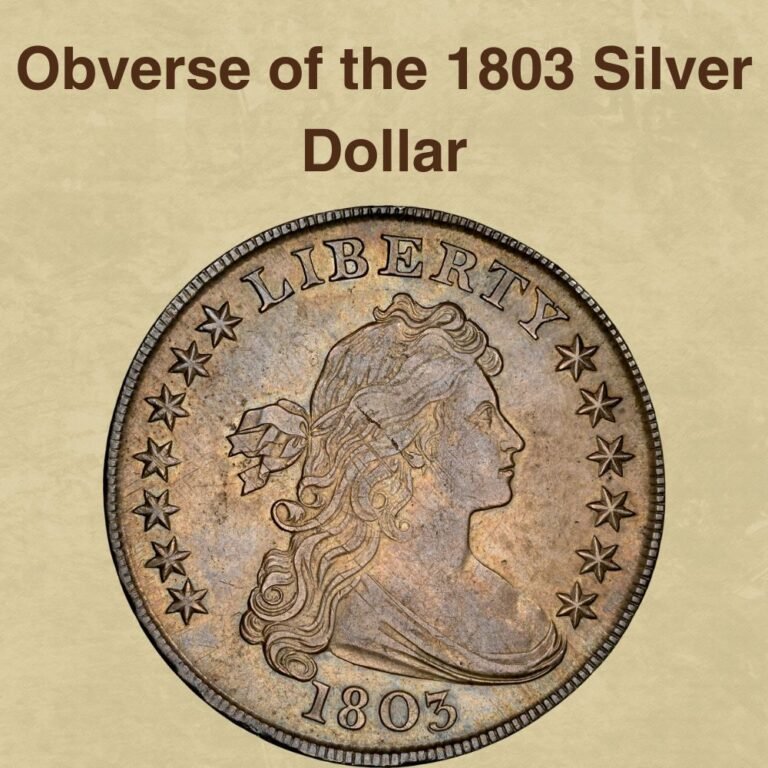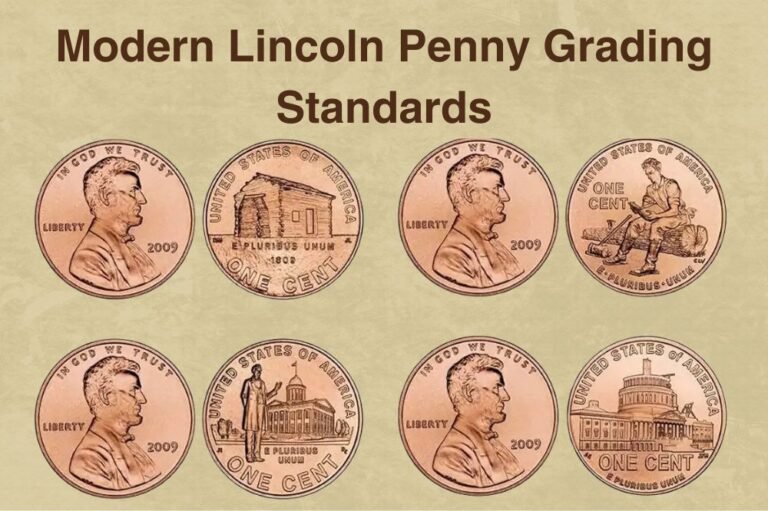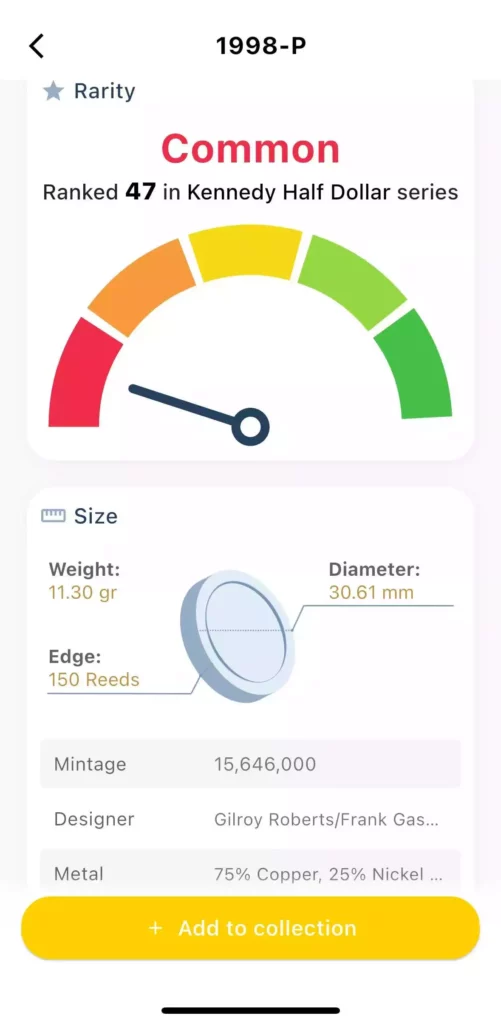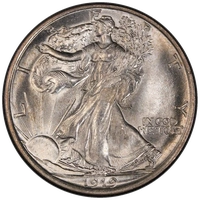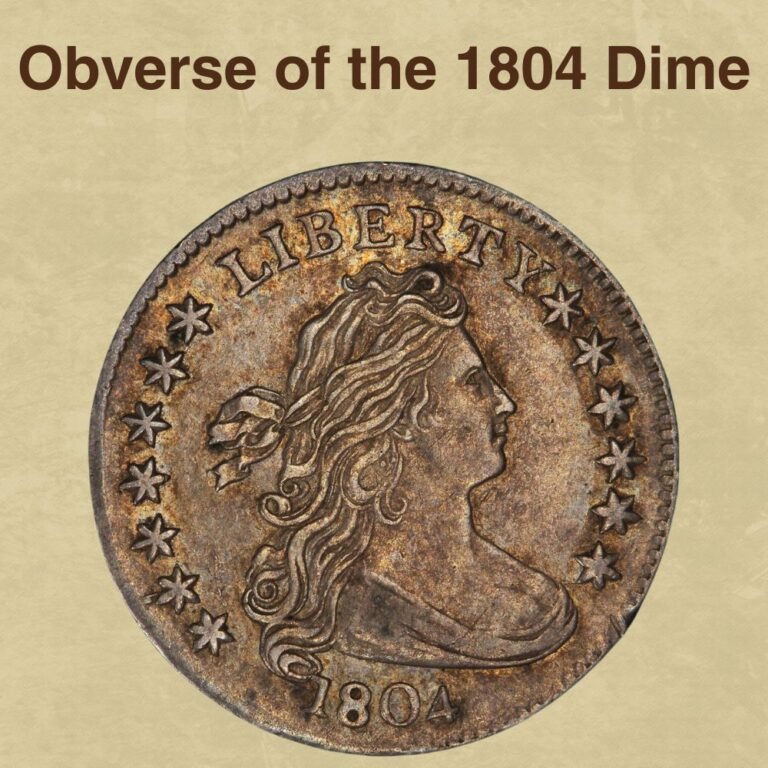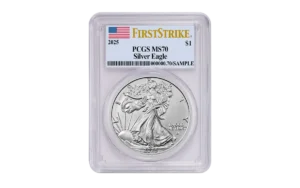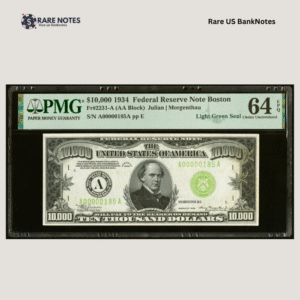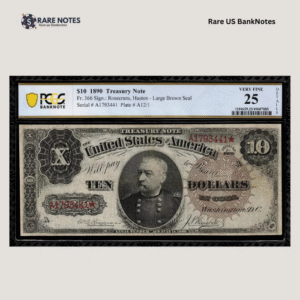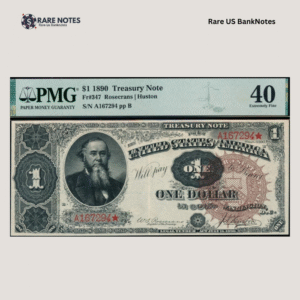Is a 1987 half dollar worth collecting? How can you tell if it is worth adding to your collection? If you’re curious about the 1987 half-dollar value, you’ve come to the right place!
The 1987 issue of the half dollar is unique in its own way—when it was first minted, it had the lowest mintage in the entire series, but this quickly changed after the United States Mint continued striking fewer and fewer half dollars in the years that followed. What’s more, the Denver Mint only issued Mint Sets, making these special coins accessible to any collector.
Eager to learn more? Read on to discover: how much is the 1987 half dollar worth?
1987 Half Dollar Value Chart |
||||
| Mint Mark | Good | Fine | Extremely Fine | Uncirculated |
| 1987-P Half Dollar Value | $0.60 | $0.60 | $0.60 | $4,100 |
| 1987-D Half Dollar Value | $0.60 | $0.60 | $0.60 | $2,600 |
| 1987-S Proof Half Dollar Value | – | – | – | $30 |
History of the 1987 Half Dollar
The 1987 half dollar is part of the popular Kennedy Half Dollar series. The five-cent coin was struck in 1964 to commemorate the assassination of President John F. Kennedy in November 1963. Just hours after the tragic incident, Mint Director Eva Adams informed Chief Engraver, Gilroy Roberts, about the plans to introduce a new Kennedy coin to commemorate the fallen president.
The silver dollar, half dollar, or quarter dollar was under consideration to be replaced by the new Kennedy coin. Upon the advice of Kennedy’s widow, Jacqueline Kennedy, the Mint decided to replace Benjamin Franklin’s half dollar with Kennedy’s new coin.
Given that production was to start in January 1964, less than three months after the assassination, there was no time to create new designs. The Chief Engraver with his assistant Frank Gasparro repurposed the existing design for a Kennedy medal they had created for the Presidential Series. Roberts repurposed the obverse while Gasparro worked on the medal’s reverse that he had designed earlier. Both, Gasparro and Roberts included their respective initials, FG and GR on the side of the coin they had each worked on.
Since design changes within the 25-year limit since production required congressional approval, a bill was introduced for Kennedy’s portrait to be displayed on the half dollar. The bill passed in December 1963, paving the way for production by January.
Initially, only proof half dollars were struck, but soon after, circulation business strike Kennedy five-cent coins were minted too, first at the Denver Mint and then at the Philadelphia Mint. The first half dollars were released into circulation by March 1964, but they were snapped up and hoarded in large numbers, leaving almost none for circulation. Over the years, the Mint struck millions of Kennedy half dollars to meet the demand for business strike five-cent but these coins hardly remained in circulation.
The year 1987 initially had the lowest mintage before the Mint further reduced mintages in the succeeding years. Since the initial production in 1964, Kennedy half dollars have not circulated much despite the large mintages. Many of these coins, including those minted in 1987, were hoarded, but the upside is that this made Mint State Kennedy halves plentiful most years.
Although abundant in circulated and uncirculated states, the 1987 half dollar is still a worthwhile addition to your collection. Mint State examples in higher grades can command a premium, significantly increasing the value of any collection.
Also read: 13 Most Valuable Franklin Half Dollars Worth Money
Features of the 1987 Half Dollar
Next, we’ll look at the physical attributes of the 1987 Kennedy half. Knowing these features helps with grading and identifying high-value Kennedy half dollars worth collecting.
Here’s what to look out for:
Obverse of the 1987 Half Dollar
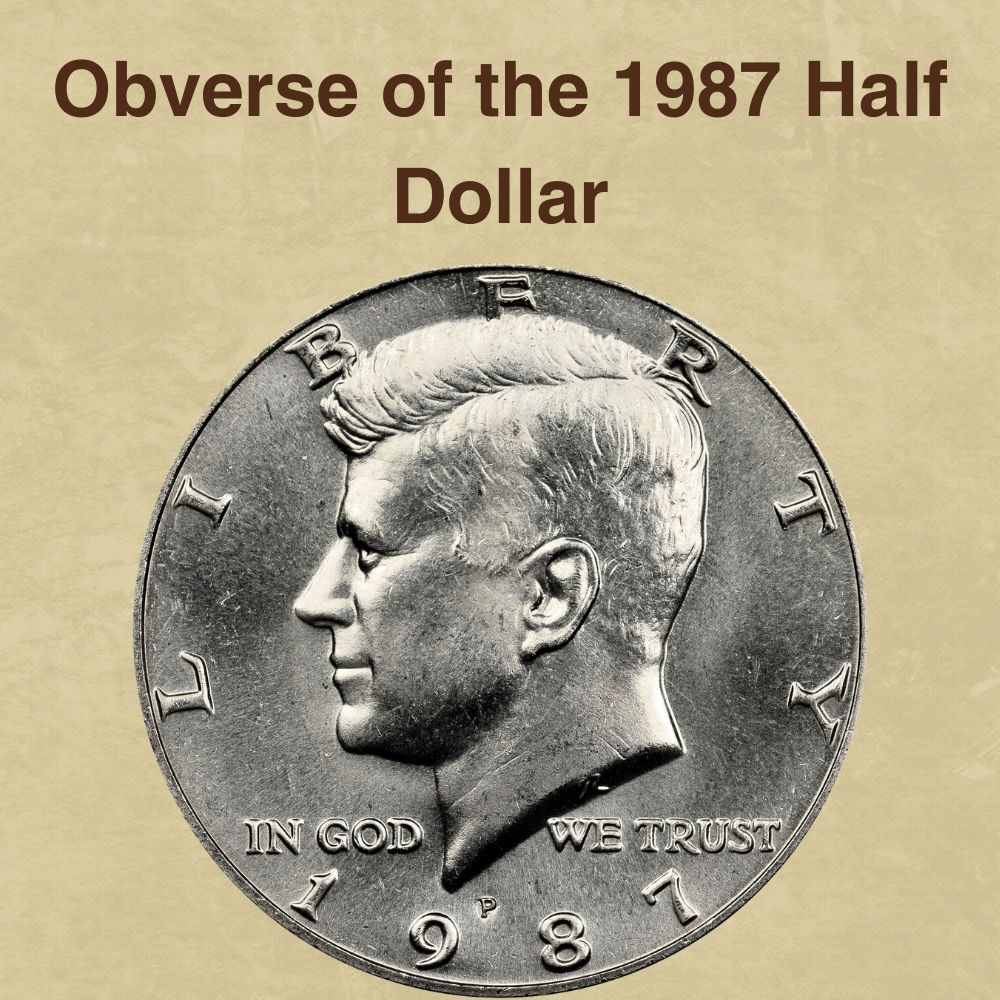
The “heads” shows Kennedy’s left-facing portrait.
The word LIBERTY appears above the portrait while the national motto, IN GOD WE TRUST, is inscribed horizontally across the portrait’s truncation. The date, 1987, is shown at the bottom along the rim.
Reverse of the 1987 Half Dollar

The “tails” displays the image of the heraldic eagle holding in its beak a flag with the motto, E Pluribus Unum, which means, “Out of Many, One.” A shield is also displayed on the eagle’s breast, symbolizing sovereignty and non-aggression.
In its left talon, the eagle holds an olive branch symbolizing peace and arrows in its right talon, representing victory and a readiness to defend the nation.
Rays of sun, crowned by billows of clouds, emerge from behind the eagle, perhaps symbolic of hope and a new dawn. The entire portrait of the heraldic eagle is encircled by stars representing the states. UNITED STATES OF AMERICA is etched at the top along the rim while the denomination, HALF DOLLAR, is inscribed at the bottom.
Other Features of the 1987 Half Dollar
Additional features worth noting include:
- Diameter: 30.61 millimeters
- Weight: 11.30 grams
- Edge: 150 Reeds
- Metal Composition: 75% Copper, 25% Nickel over a Copper center
Also read: 13 Most Valuable Kennedy Half Dollar Worth Money
1987 Half Dollar Value Guides
Now, onto the big question: How much is a 1987 half dollar? The value depends on factors such as the coin’s condition, mintage and rarity, and mintmark.
We’ll look at the two business-strike varieties of the 1987 half dollar and the proof. The three varieties include:
- 1987-P Half Dollar
- 1987-D Half Dollar
- 1987 Proof Half Dollar
Let’s find out how much each is worth.
1987-P Half Dollar Value

About 2,890,758 half dollars were struck at the Philadelphia Mint in 1987. The 1987-P half dollars were, for a while, considered to have one of the lowest mintages, but in the years that followed, the Mint struck very low mintages, making the 1987 half dollar relatively common across all grades.
Here’s a breakdown of the values:
Circulated Examples: These are abundant and extremely affordable in all grades. Examples graded Poor/Average all through to those graded Extremely Fine (XF55) are worth $0.60, which is more or less the coin’s face value. The value increases slightly for an About Uncirculated example (AU58), which will sell for about $0.75.
Mint State Examples: Uncirculated specimens are also plentiful up to grade MS65. Gems graded MS67 are far and few between, but a few hundred of them probably exist. In grade MS68, survivors are genuinely rare, with fewer than 10 known examples. In MS60 pieces sell for up to $1.50 and as much as $5 in MS62. In MS63, expect up to $7.50 and as much as $20 in MS65. Examples in MS66 are scarce and will sell for up to $45, and the prices shoot up significantly in MS67, where specimens command as much as $500 and up to $4,100 in MS68.
Auction Record: In a record-shattering sale, Stack’s Bowers auctioned an MS68 for an impressive $4,800.
1987-D Half Dollar Value
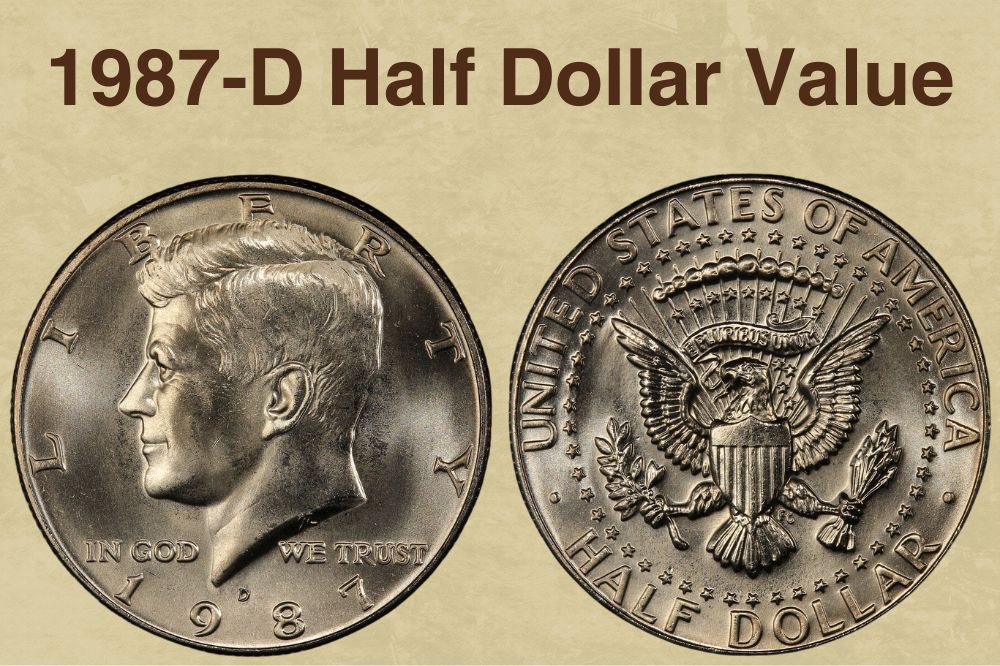
We’ll now look at the 1987-D half dollar, which had a mintage of 2,890,758. None of these five-cent coins were released into circulation that year, i.e., the Mint issued the 1987-D half dollar in Mint Sets only, and collectors could buy them directly from the Mint.
So, how much are 1987-D half dollars worth? Here’s what to expect:
- Mint State Examples: Most 1987-D half dollars are graded as Mint State as they were never released into circulation. So, uncirculated examples in this issue are plentiful but become scarce in grade MS67 and higher, with only a few hundred examples known to exist. Specimens in MS68 are genuinely scarce, with fewer than a dozen on these gems graded by the Professional Coin Grading Service. In MS60, examples will sell for as much as $1.50 and up to $5 in MS62. Pieces are still quite affordable in MS65, where they fetch up to $20. Prices rise significantly for gems in MS67, where they sell for as much as $235 and up to $2,600 in MS68.
- Auction Record: In 2015, Heritage Auctions sold an MS68 for $3,055, making this one of the most valuable 1987-D half dollars.
1987-S Proof Half Dollar Value

The San Francisco Mint struck 4,227,728 proof half dollars in 1987, a much higher mintage than the business strikes from Philadelphia and Denver. It is safe to say that there are enough 1987-S proof half dollars to meet collectors’ demand.
Here’s a breakdown of how much these special strike coins are worth:
- Regular Proofs: These are plentiful and affordable across all grades. In PF60, expect about $1.50 and up to $2.75 in PF63. Proofs graded PF65 will fetch as much as $5, while a Gem example in PF70 is worth at least $30.
- Cameo and Deep Cameo: Cameo and Deep Cameo examples are scarcer than their regular cameo counterparts but are equally affordable in all grades. For example, in PF60, a cameo costs $1.25, while a deep cameo sells for up to $1.75. In PF63, a cameo can sell for as much as $3, and a DCAM can reach up to $3.50. In grade PF67, DCAMs are worth about $17.50, while cameos sell for about $12.50. Gem cameos in PF70 are valued at up to $55, whereas deep cameos can be worth as much as $100.
Also read: 11 Most Valuable Half Dollars In Circulation
1987 Half Dollar Grading
Grading a 1987 half dollar entails examining the coin for wear on high contact points and for luster. Despite the high mintage, Kennedy half dollars were generally well-struck.
Circulated examples will, however, show wear on high contact points such as the top of Kennedy’s hair, his ear, and jawline. The word LIBERTY will also be worn on lower-grade coins. On the reverse, look for signs of wear on the shield, talons, and the area around the billow of clouds. The inscription, HALF DOLLAR, will also be worn on lower-grade coins.
While lower-grade half dollars will have a dull surface with signs of damage such as scratches and dings, higher grade specimens have a brilliant mint luster, and a smooth, problem-free surface.
Check out this video for more tips on grading Kennedy Half Dollars like an expert.
Rare 1987 Half Dollar Errors List

Minting errors can significantly raise the value of your half dollar. In addition to Mint State examples that are the most desirable to collect, half dollars with minting flaws can also add great value to your collection.
Here are some in the 1987 half-dollar series that are worth collecting:
1. 1987 Half Dollar Rim Cud Error
A rim cud error occurs when a piece of the die’s rim falls off and the gap is eventually filled with small metal pieces, resulting in a raised bump along the die’s rim. As it strikes the planchet, the die transfers the impression of the raised bump onto the coin’s rim, creating a rim cud. Large, visible, and dramatic rim cuds are generally more valuable. In 2022, a collector on eBay paid an impressive $50 for a 1987-D half dollar graded MS65 with a large rim cud error.
2. 1987 Half Dollar Misaligned Die Error
Another error that’s often seen on some 1987 half dollars is the misaligned die, which occurs when there’s an offset between the obverse and reverse dies.
Instead of the dies striking the planchet in an upright position, one or both dies might be rotated at an angle, causing the design on either side of the coin to appear tilted.
The greater the misalignment, the more eye-catching and valuable the error tends to be. For example, a 40-degree die rotation will generally be more valuable than a subtle 10-degree rotation.
In 2022, Stack’s Bowers auctioned a 1987-D half dollar graded MS67 with a 45-degree die rotation for an impressive $400.
3. 1987 Half Dollar Doubled Die Error
Doubled-die errors are common in the Kennedy Half Dollar series but are a worthwhile addition to any collection.
This error occurs when the die strikes the planchet multiple times at different angles, causing the design elements and inscriptions to overlap or acquire a ghost-like outline.
Stronger, more visible doubling is more valuable than a subtle doubled die error. In 2020, an eBay collector paid $90 for a 1987-P half dollar graded MS66 with an obverse doubled die error.
Where to Sell Your 1987 Half Dollar?
Now that you know the value of your coins, do you know where to sell those coins online easily? Don’t worry, I’ve compiled a list of these sites, including their introduction, pros, and cons.
Check out now: Best Places To Sell Coins Online (Pros & Cons)
FAQs
Are 1987 half dollars worth anything?
Yes. Higher-grade 1987 half dollars are worth more than their face value. Some gems graded MS67 and higher are worth several hundred dollars, making them a valuable addition to any collection.
How many 1987 Kennedy half dollars were minted?
Combined, the 1987 Kennedy half dollars from the Philadelphia and Denver Mints total to about 5.7 million. When you add the approximately 4.2 million proof half dollars minted the same year, a total of approximately 10 million Kennedy half dollars were produced in 1987.
How do I know if my 1987 Kennedy Half Dollar is valuable?
Gem-quality Kennedy half dollars are generally the most valuable. These coins have a brilliant luster and a problem-free surface. Half dollars with notable minting errors can also be worth significantly more than a regular coin.
The post 1987 Half Dollar Coin Value (Errors List, “P” & “D” Mint Mark Worth) appeared first on CoinValueChecker.com.



